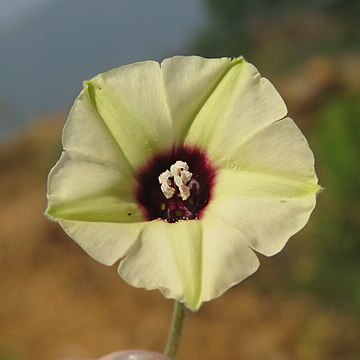Herbs perennial. Stems herbaceous; axial parts ± densely pubescent, twining or prostrate, 1-2 m, occasionally rooting at nodes. Petiole 1-6 cm; leaf blade ovate, 3-10 X 3-8 cm, appressed pilose or subglabrous, sometimes yellow glandular ?dotted, margin ciliate, base cordate, hastate, or truncate, margin entire or 3-lobed, apex acuminate, acute, or mucronate. Inflorescences often 1-flowered; peduncle 1.5-10 cm; bracts oblong-lanceolate, 0.7-1.5 cm, pubescent, acuminate. Pedicel 2-4 mm. Sepals unequal, pubescent abaxially; outer 3 broadly ovate, 0.9-1.5 cm X 6-9 mm, to 1.7 cm in fruit; inner 2 oblong-lanceolate, smaller. Corolla pale yellow or whitish, with a purple center, 2-2.5 cm, midpetaline bands densely pilose. Stamens ca. 9 mm; filaments minutely papillate basally; anthers ovoid-deltoid. Ovary villous. Capsule enclosed by persistent calyx, depressed globose, 8-10 mm in diam., pilose. Seeds dull black, ovoid-trigonous, 4-6 mm, glabrous except for pubescent hilum. Fl. and fr. year round. 2n = 30.
Twining or prostrate, ± pubescent, perennial herb. Stems up to 3 m long, angular. Leaves variable, oblong to broadly ovate, 25-140 x 10-60 mm. Peduncles 5-100 mm long, 1-flowered; pedicels up to 5 mm long; bracteoles 5-17 mm long. Sepals lanceolate to ovate, up to 17 mm long; outer ones accrescent in fruit. Corolla campanulate to funnel-shaped, 20-35 mm long, pale yellow or white, centre usually maroon or purple; lobes very short, rounded, emarginate; midpetaline areas pilose outside. Ovary densely hairy, 1-locular. Style simple, included; stigmas 2, flattened. Flowering time all year, mostly Aug.-Jan. Fruit a 1-locular, depressed-globose capsule, 8-10 mm long, 4-valved; style persistent. Seeds 2-4, black, glabrous, 5-6 mm long.
A slender herb. It lies along the ground and keeps growing from year to year. It can be twining to a height of 3 m. It can form roots at the nodes. The leaves are alternate and simple. The leaf stalks are 9 cm long. The leaf blade is oval and 2-14 cm long by 1-10 cm wide. There can be teeth along the edge. The flowers are in the axils of the leaves. The ring of flower petals is yellow with a purple throat. The fruit is a rounded capsule. It is 1 cm across. There are 4 valves and 2-4 seeds.
Twining or prostrate perennial herb. Leaf oblong or ovate to broadly ovate, cordate, hastate, cuneate or sometimes truncate at base, dentate or entire, pilose to velvety on both surfaces. Corolla 20-35 mm long. Flowers pale yellow or white, usually with purple or claret centre.

